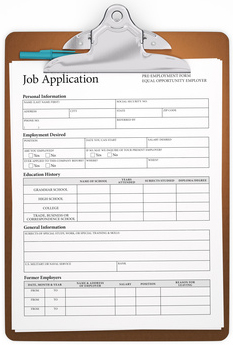How to complete a job application form
Need help filling in that application form? Welcome to CV-Shops’ application form guide free resource, including a handy application form checklist.
Getting started on the application form
- Fill out the application form in a quiet, private space, preferably well away from small children and potentially disastrous spillages! Take your time. Do not attempt to complete the form when you are in a hurry or distracted by other priorities.
- Before you begin, read the application form thoroughly from start to finish and take note of any special instructions. Complete the form using black ink.
- Photocopy the application form and use this copy to write your first draft. This will enable you to consider and practise what you are going to write, and that you are able to fit it into the required space. Don’t write on the actual form until you are sure about what you want to say.
- Before you begin, remember to go online and research the company and the job you are applying for. Do you have the qualifications, experience and skills that the employer demands?

Answering the questions on the form
Remember that the answers you give to these questions will be key to your success in securing an interview. Give them careful consideration.
Focus on the qualities that the employer is looking for, and position your answers to demonstrate that you fulfil their requirements.
Give detailed and concise answers that supply the essential information without waffling.
Don't forget to mention part time jobs and voluntary work. They enable an employer to gain an insight into your attitude and abilities.
Don't simply list your interests, e.g.: ‘cycling, cinema, travel, etc’. This will not tell the employer much about you. Instead, include details of your interests, e.g.: ‘Competed in cycle trials in the French Alps with my local cycling club in 2008, gaining a club record time for my class...’
Many application forms contain competency-based questions, i.e. those beginning with "Describe an example of when you …, etc, etc.’ and asking for examples of team work, leadership, negotiation skills, etc. Remember to describe how your personal input resulted in a successful project or task, or how you’ve managed to influence the outcome of an important decision, etc. Give specific examples.
References
Many employers do not take up references until after the final interview, although they are usually required to be included on application forms.
In most cases, employers ask for one academic and one personal reference. If you are applying for postgraduate study, two academic referees are often required.
Your academic reference does not necessarily have to come from your personal tutor. If you think it would be better coming from another member of the teaching faculty who knows you better, it is perfectly acceptable to ask them.
If it has been some time since you were in full time education and it is not possible to obtain an academic reference, then it may be substituted for a professional reference.
Your personal referee may be a former employer, a family friend (preferably a professional person) or a teacher or tutor.
It is important that you ask your referees for permission to include their names. Tell them about the job you are applying for, and if possible include a copy of the application form to help them with their response.
Ethnic origin
Many application forms will ask for details of your ethnic origin.
This section does not form part of the selection process, but is included so that employers can measure the success rate of ethnic minority applicants. These questions are optional, so if you prefer not to answer them you should not be penalised.
Application form presentation checks:
- Complete all the required information. Don't leave any blank spaces unless they clearly don’t apply to your application.
- If there isn’t enough space for what you want to say, use a covering letter to highlight the key points and expand upon them.
- When listing your employment information, begin with your most recent job and work backwards.
- List your most recent education first. Remember to include training courses as well as schools and universities.
- Carefully proofread the form before handing it in. Check for spelling and grammatical errors, and don't forget to sign it.
- If you are completing the form by hand, make sure your writing is neat and tidy with no crossings-out or excesses of correction fluid. It is usually acceptable to complete the form in capitals, if you prefer.
- Include a covering letter with your application highlighting your achievements, skills and experience.
Finally, keep a copy of every application form that you complete. If you are invited for an interview, it can be very helpful to go back over the application form to recap on what you have told an employer.
That’s all for now. We sincerely hope you’ve found this application form guide helpful. And happy job hunting!
Best wishes
The CV-Shop Team
Need help with your CV or covering letter? CV-Shop is here to help.

You may also be interested in:
We accept all major payment methods:













